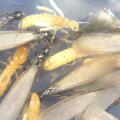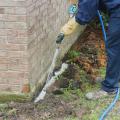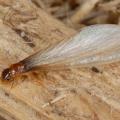Signs of Termite Infestation
How do you know if a building is infested with termites? There are three major clues.
- You see termite swarmers, either alive or dead, inside the building.
- You find mud shelter tubes traveling up the foundation of the building, either outside or in the crawl space.
- You find termite damage in the building.
Let’s consider some specific examples of each of these situations.
You see swarmers emerge inside the building, or find dead swarmers on the floor or windowsill.
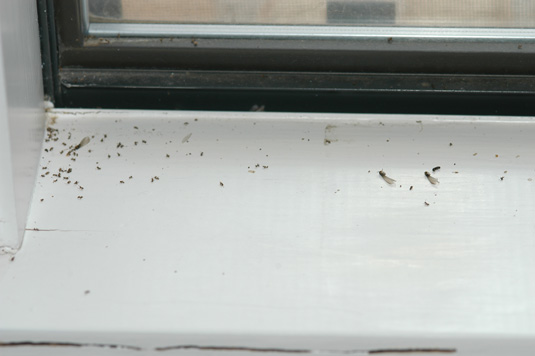
Finding termite swarmers inside a building is a sure sign the building has an active termite infestation and needs to be professionally treated. Call the pest control company and arrange to have the building inspected and treated.
It takes several years for a termite colony to grow large enough to be able to produce swarmers. If large numbers of swarmers are emerging inside a building, this means that there is a large colony of termites feeding on that building. Note that killing the swarmers does nothing to solve the problem. Swarmers that emerge inside a building will die anyway because they are not able to reach moist ground where they will have a chance to survive and start a new colony. However, the colony that produced them will continue to thrive—unless it is treated.
Exception: In neighborhoods that are heavily infested with Formosan termites, finding just a few Formosan termite swarmers (Figure 2) inside a building that is known to be properly treated does not necessarily mean the building has an active infestation. Because Formosan swarmers are so strongly attracted to lights, swarmers from trees and other outside colonies may accidentally enter buildings at night during swarm season. Finding a few dozen Formosan swarmers inside a building in this situation may not be the result of an active infestation, but finding hundreds of Formosan swarmers is a definite indication of a current problem, regardless of the treatment history of the building. Buildings in areas known to be infested with Formosan termites need to be properly treated for termites and inspected annually, regardless of whether or not the building has ever been infested.
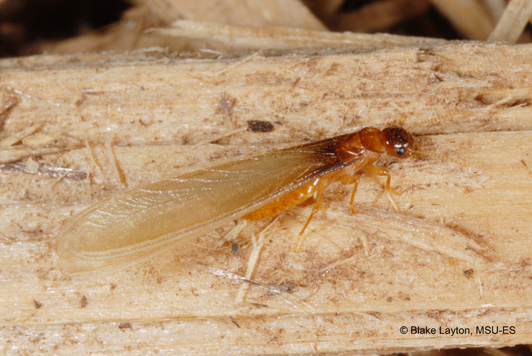
You see swarmers emerge outside but very near the building’s foundation.
This may or may not mean the building is infested, but it is definitely cause for further investigation. Get a professional inspection. If you do not know when the building was last treated for termites, or if it was treated so long ago that the treatment has likely broken down, this is a good reason to have it treated.
You see swarmers emerging from a stump, log, pile of wood or other source out in the landscape but well away from the foundation of the building (25 feet or more), or you find active termites in such a situation.
This is rarely a cause for concern. It is normal for termites to be in these types of situations. The termites are where they should be and they are doing what they should be doing—helping to breakdown and recycle dead wood. Still, if you do not know when the building was last treated for termites, this can serve as a reminder to check your records and to have the building inspected. Don’t worry about trying to control these termites “before they get into the house.” Just make sure the building is properly protected.
You find mud shelter tubes traveling up the outside foundation wall, inner foundation wall, up support piers or plumbing under the house, or similar situations.
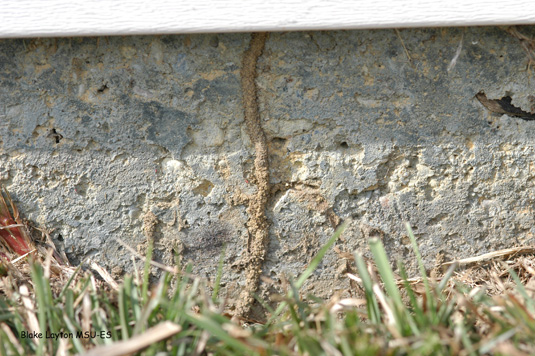
This is usually a sure sign that a building is infested. Carefully break a 1-inch section of the tube and watch to see if you observe termites (Figure 4) or if they repair the tube over the next few days. Either of these results lets you know the building has an active infestation. Note that simply destroying the tubes will not control the termites; they are still there in the ground and will find other ways to get into the building. Also keep in mind that the mud tube(s) you can see may not be the only places where termites are entering the building.
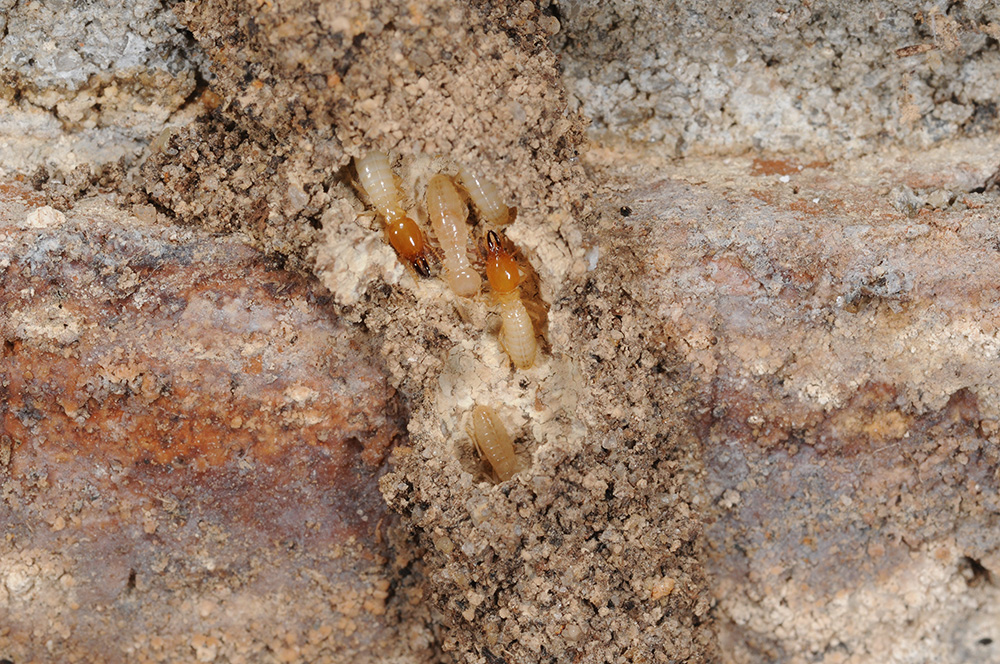
If you find mud shelter tubes, it is a good idea to have the building professionally inspected even if you do not see live termites or see that the tube is repaired after being broken. The only exception would be if you are certain these are old tubes left over from a previous infestation that has already been controlled. However, old, inactive shelter tubes should be completely removed/scraped away so they will not cause confusion on subsequent inspections.
You notice mud shelter tubes higher up on the building, either on interior walls or ceilings, or on exterior walls, soffit, or fascia boards.
This is usually a sign of a Formosan termite infestation. Get a professional inspection.
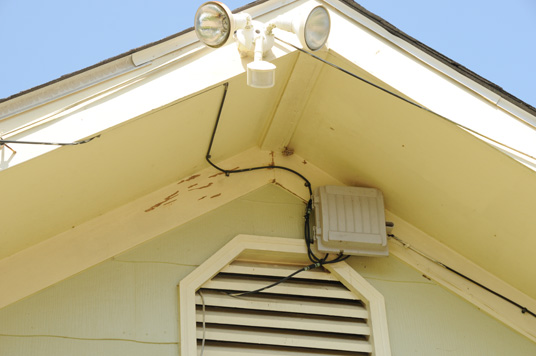
You notice one or more BB-sized spots of dried mud on an inside wall or ceiling of sheetrock, wood paneling, or other wall covering.

Scrape away the mud to see if there is a hole underneath (Figure 7) and watch closely to see if a termite comes to investigate. Mark the spot and note whether it is repaired over the next few days. These are known as “pinholes” in the pest control trade. They occur when termites accidentally cut an opening to the outside, which they promptly repair with mud because they do not like exposure to the outside airflow. This is a sure sign of an active termite infestation. Get a professional inspection.
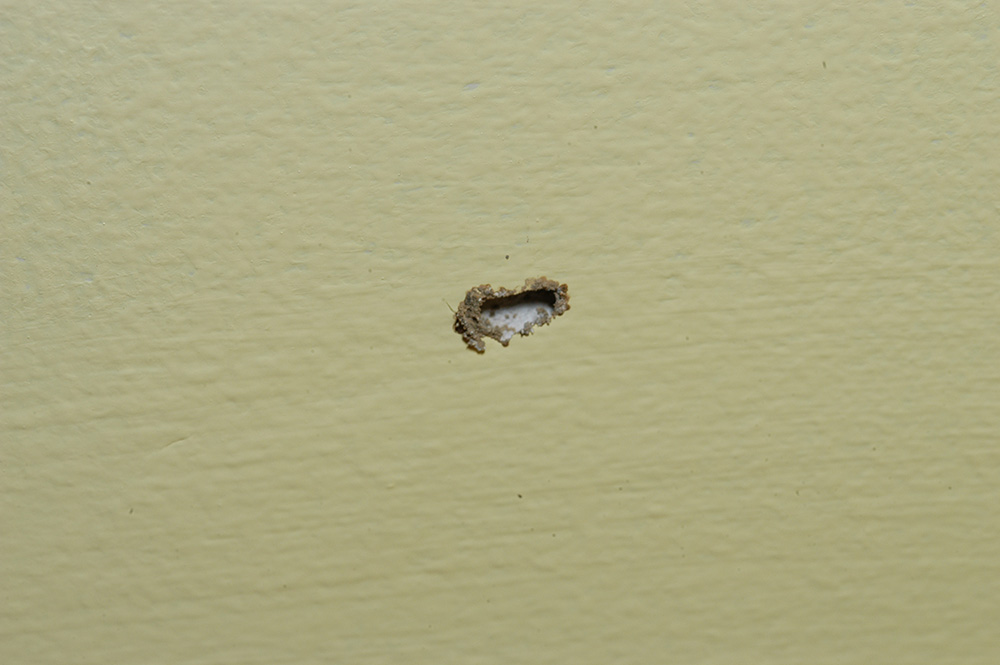
You notice narrow, sunken winding lines, or sunken areas, in wallpaper, paint or other surfaces.
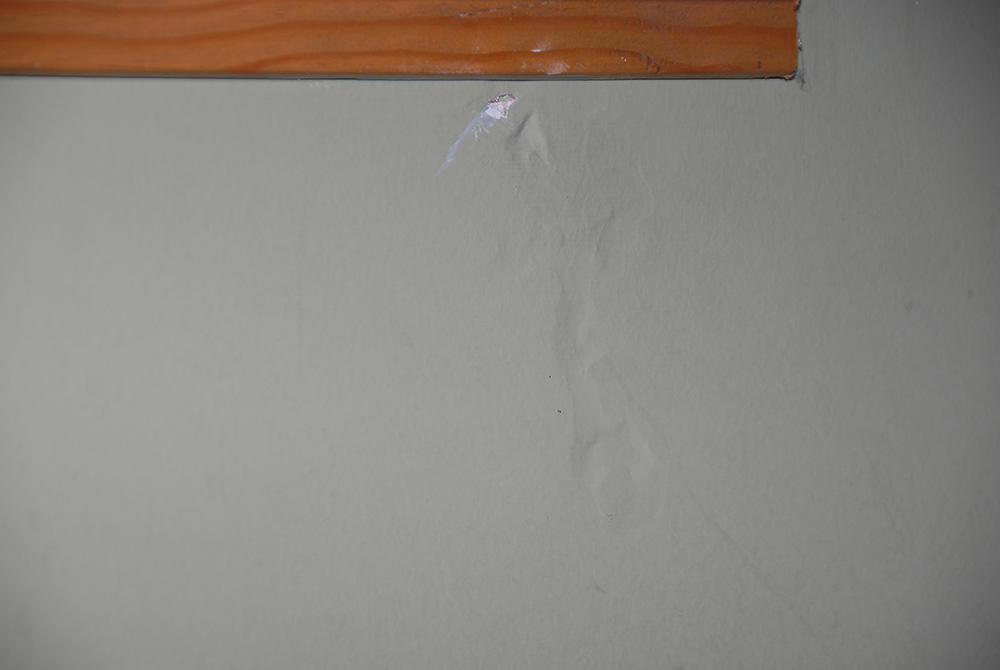
This could be due to termite galleries located just beneath the surface. Termites do not eat the gypsum in sheetrock, but they will eat the outer cardboard covering, usually without disturbing the thin coat of paint on the surface of the sheetrock, and they will eat wood paneling. Get a professional inspection.
You notice odd-shaped formations of dried mud sprouting from the walls or ceiling in late spring.

These are probably “swarm castles” built by Formosan termites in preparation for swarming. Break into these and you will probably see soldiers coming to defend the breech in the colony. Start getting bids for a termite treatment.
You notice mud tubes traveling over or through foam insulation.

This is most often a sign of Formosan termite infestation, but eastern subterranean termites can also behave like this. Even though termites do not eat foam insulation, they will tunnel through it in their search for wood to feed on.
You encounter termite damage when removing wall paper (Figure 11), doing home repairs, or remodeling.
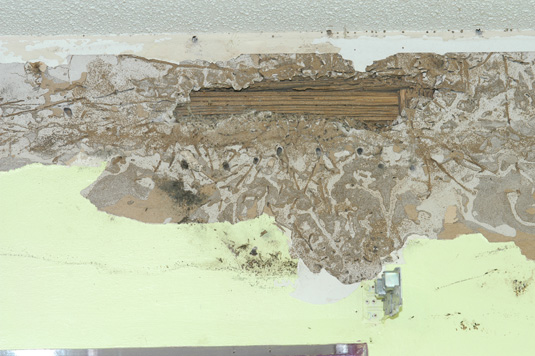
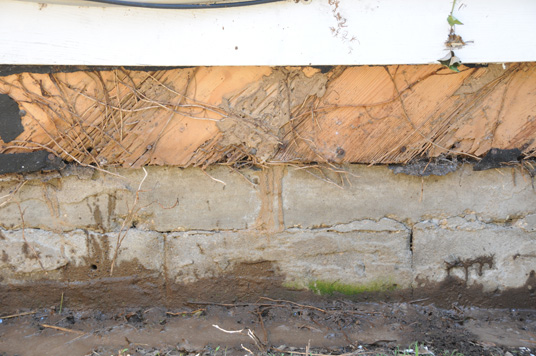
If you actually see termites, you know this is an active infestation, but be aware that termites will quickly leave an area after it has been disturbed. If there is dried mud in the galleries, this is a sign of termite damage, but if there are no termites present, this could be old damage from an infestation that was controlled at some time in the past. Get a professional inspection.
You notice structural problems such as a sagging floor or roof, or more obvious problems like a broken door frame.
Of course, this could be due to wood rot or other causes, but if you find damaged timbers with galleries containing dried dirt, this is termite damage. If you actually see termites in the damaged wood, you know this is an active infestation. In either case, get a professional inspection.
You find an accumulation of small, uniform-sized, six-sided pellets on a floor or countertop.
This is a sign of drywood termite activity (Figure 13).
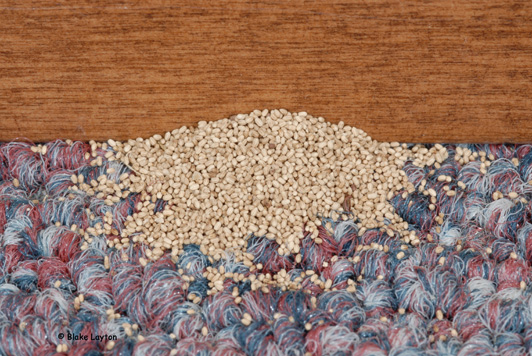
Note that a building will usually have been infested for some time before any of the above signs become obvious. Termites are inherently difficult to detect because they are hidden by the soil and wood in which they live and because they can enter buildings through hidden cracks and crevices in the foundation. Infestations rarely become evident until populations have grown large enough to cause some visible damage or produce swarmers. Shelter tubes are one possible exception. A shelter tube detected going up the outside of a foundation wall could be due to a recent, initial attack, but it is also possible that the building has been infested for several years and this is simply the first time the colony built a shelter tube in an area where it could be seen.
The key point here is that just because a building has been thoroughly inspected without detecting termites or signs of termites, this does not necessarily mean the building is free of termites. There is always the potential for a building to harbor hidden infestations. The best way to defend against hidden termite infestations is to make sure buildings are properly protected with preventive treatments and to have buildings inspected annually.
Dr. Blake Layton, Extension Entomology Specialist
Department of Entomology, Mississippi State University
Phone: 662-325-2960
Email: blake.layton@msstate.edu
Publications
News
Mississippi’s native subterranean termites have started swarming, and these structure-destroying insects will continue to swarm across the state over the next few months.
John Riggins, professor of forest entomology in the Mississippi State University Department of Agricultural Science and Plant Protection, said termites swarm to produce new colonies when the weather warms up, often after a rain.
Termites exist all over Mississippi and will eventually infest and damage any structure that contains wood or other cellulose components unless you properly protect those structures.
Invasive Formosan subterranean termites were first found in the state 40 years ago, and soon, these dangerous pests will swarm and threaten unprotected structures in about one-third of Mississippi’s counties.
Santos Portugal, Mississippi State University Extension Service urban entomologist, said Formosan termites typically swarm in the millions from early May to early June. They have the ability to infest and significantly damage structures much more quickly than native subterranean termites.
Success Stories
A dream of the Mississippi Pest Control Association and the Mississippi State University Extension Service is coming true after more than 20 years, thanks to a generous donation by one of Mississippi’s oldest pest-control companies.


